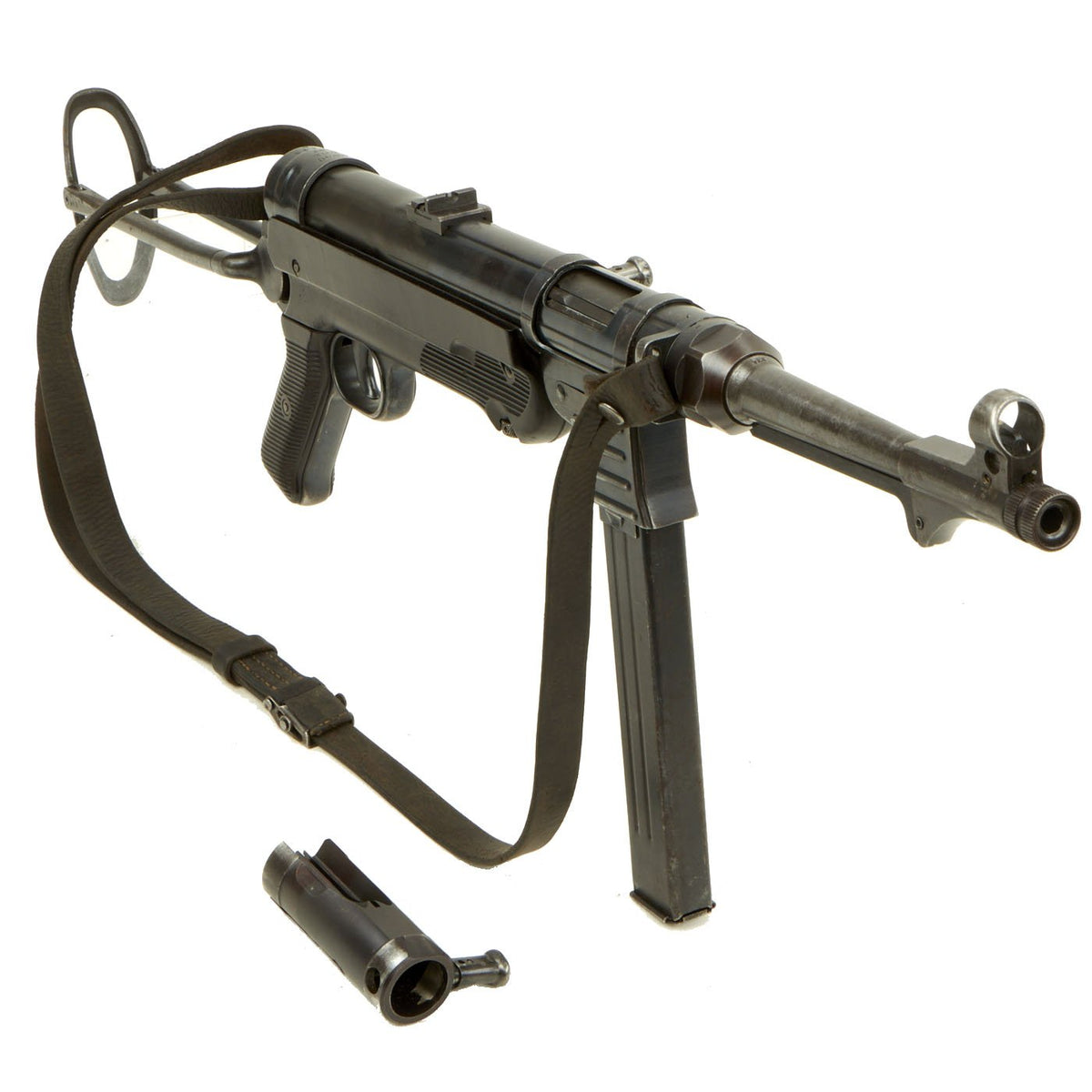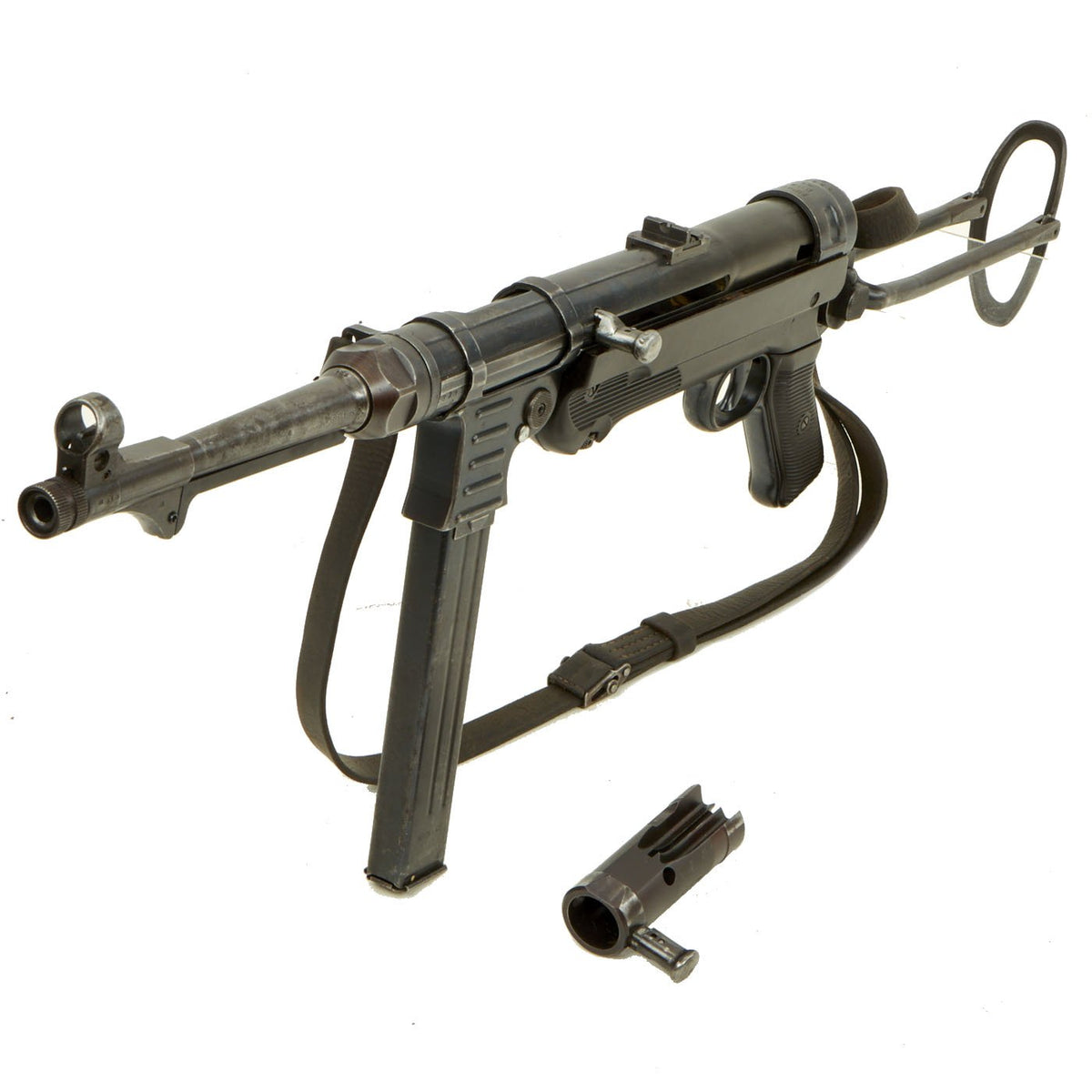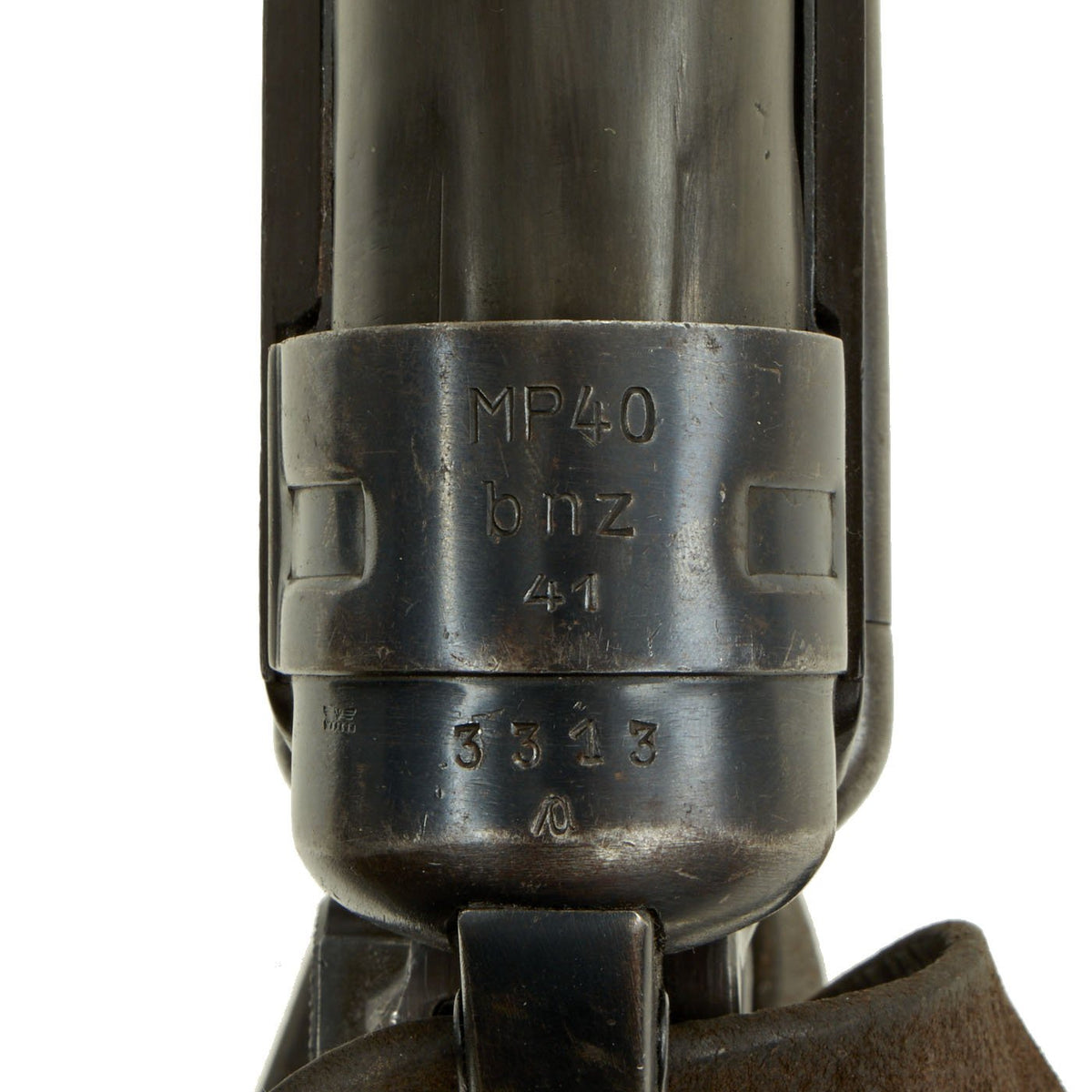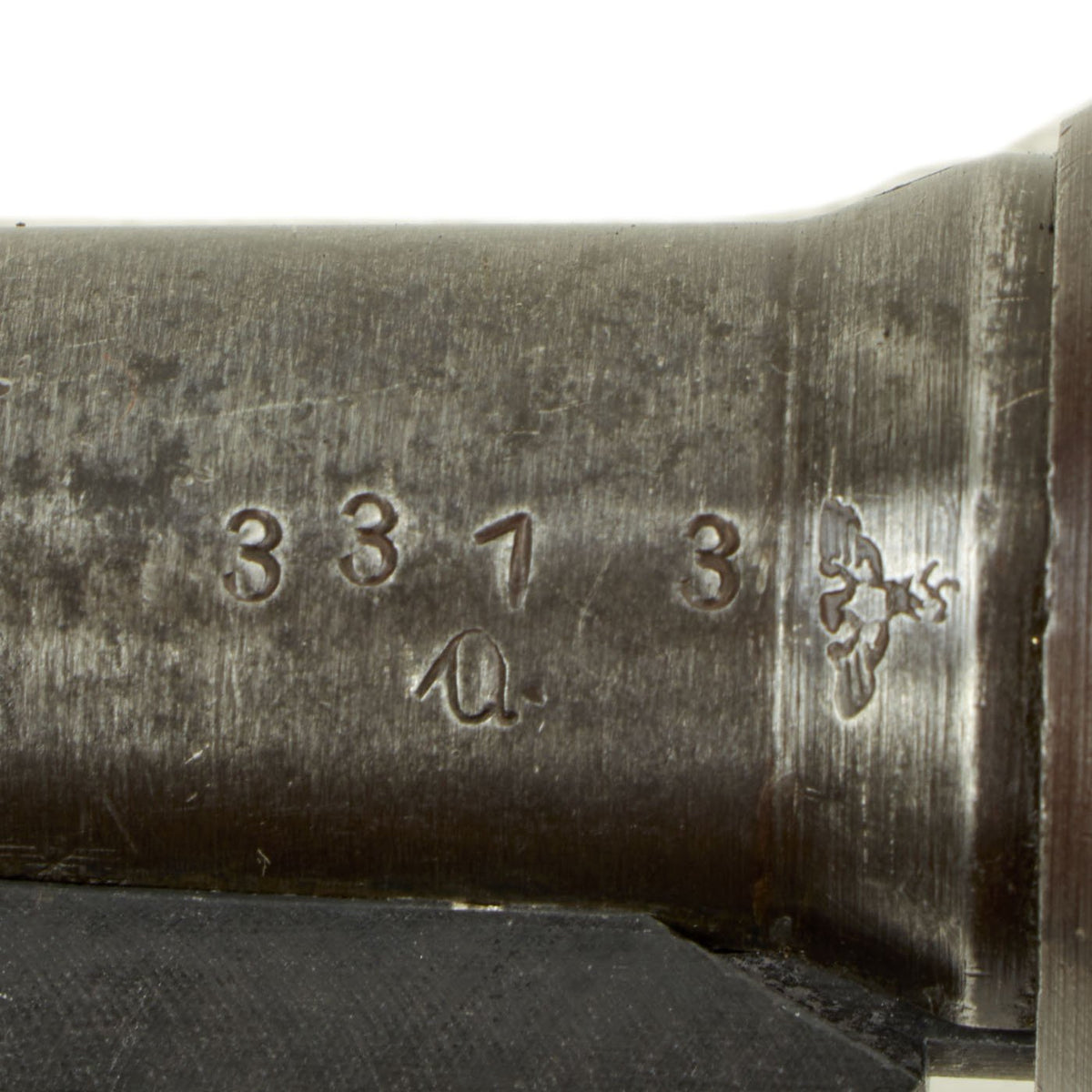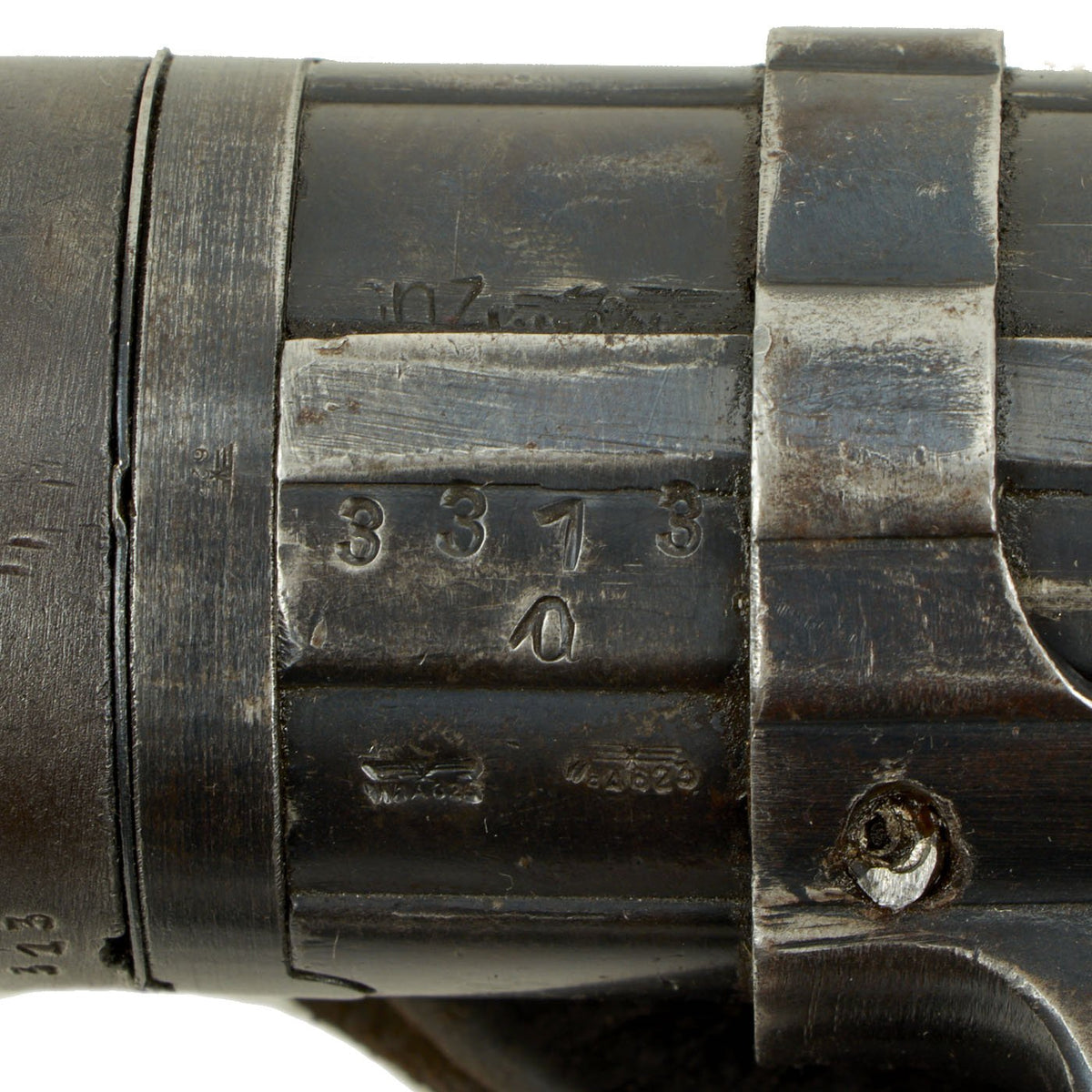Original German WWII 1941 dated MP 40 Display Gun by Steyr with Live Barrel, Bolt & Magazine – Matching Serial 3137 a Original Items
$ 5.995,00 $ 1.498,75
Original Item: One-of-a-kind. This is an excellent condition MP40 Maschinenpistole 40 display gun, built built from all original parts on an original BATF approved display receiver. It has properly had a 2 inch portion replaced entirely with solid steel bar stock, making this totally legal to own without a license of any kind. We have very rarely had examples constructed using an original receiver. Even better, the original serial number matched bolt head was not used during construction, and is included as well.
Offered with exceptional original dark brown bakelite stock and grips, this is the real thing that will only appreciate in value over time. The extending butt stock is present and fully functional, though it has been bent downwards slightly, so when extended the end is somewhat higher than normal. We do not see how this bend was possible without breaking it, so we assume it is an armorer modification. A deactivated MP40 bolt has been welded into the forward position inside the demilled receiver, with the safety handle still functional. The barrel is original and has not been deactivated in any way, and the bore is in very good condition, with clear lands and grooves. Original markings have been maintained and make a keystone item for any serious WWII collection.
The rear receiver cup of this display gun is marked with the date and manufacture codes, which are clear:
MP40
bnz
41
3313
a
This indicates 1942 manufacture by Steyr-Daimler-Puch AG, Werk Steyr, the legendary Austrian arms company. The trigger guard, barrel, and receiver all bear matching serial number 3313 / a, and the front sight, all parts of the folding stock, and rear sight bear shortened number 313. Even the BOLT is marked 3313 a! Before being imported and deactivated, this was a very desirable “ALL MATCHING” example, and its a great one! There are also multiple Waffenamt proofs on various parts of the display gun.
Included is an original MP 40 magazine, in very good condition, which is correctly marked MP. 38 u. 40 on the side, with maker code kur 43 on the back for 1943 production by Steyr-Daimler Puch AG, Werk Graz in Poland. It also bears the correct Waffenamt WaA815 code for this factory. Magazine will have the spring and follower removed if shipped to a state that prohibits high capacity magazines.
The included original sling is in good service used condition, and while the original markings are gone, it is definitely original. It has the correct knurling on the inside of the buckle to help hold the leather securely, and the buckle slider and outer housing are completely correct. The leather was originally cross hatched with a border, but that is now faint.
A great chance to pick up a very great MP40 display gun with a live barrel & bolt, complete with an original sling & magazine! We rarely seem them this nice an complete! Ready to display!
History of the MP40
The Maschinenpistole 40 (“Machine pistol 40”) descended from its predecessor the MP 38, which was in turn based on the MP 36, a prototype made of machined steel. The MP 36 was developed independently by Erma Werke’s Berthold Geipel with funding from the German Army. It took design elements from Heinrich Vollmer’s VPM 1930 and EMP. Vollmer then worked on Berthold Geipel’s MP 36 and in 1938 submitted a prototype to answer a request from the Heereswaffenamt (Army Weapons Office) for a new submachine gun, which was adopted as MP 38. The MP 38 was a simplification of the MP 36, and the MP 40 was a further simplification of the MP 38, with certain cost-saving alterations, most notably in the more extensive use of stamped steel rather than machined parts.
It was heavily used by infantrymen (particularly platoon and squad leaders), and by paratroopers, on the Eastern and Western Fronts. Its advanced and modern features made it a favorite among soldiers and popular in countries from various parts of the world after the war. It was often erroneously called “Schmeisser” by the Allies, despite Hugo Schmeisser’s non-involvement in the weapon’s design and production. From 1940 to 1945, an estimated 1.1 million were produced by Erma Werke.
Fast Shipping with Professional Packaging
Thanks to our longstanding association with UPS FedEx DHL, and other major international carriers, we are able to provide a range of shipping options. Our warehouse staff is expertly trained and will wrap your products according to our exact and precise specifications. Prior to shipping, your goods will be thoroughly examined and securely secured. We ship to thousands clients each day across multiple countries. This shows how we're dedicated to be the largest retailer on the internet. Warehouses and distribution centres can be located throughout Europe as well as the USA.
Note: Orders with more than one item will be assigned a processing date depending on the item.
Before shipping before shipping, we'll conduct a thorough inspection of the items you have ordered. Today, the majority of orders will be delivered within 48 hours. The delivery time will be between 3-7 days.
Returns
The stock is dynamic and we cannot completely manage it because multiple stakeholders are involved, including our factory and warehouse. So the actual stock may alter at any time. It's possible that you may not receive your order once the order has been made.
Our policy is valid for a period of 30 days. If you don't receive the product within 30 days, we are not able to issue a refund or an exchange.
You can only return an item if it is unused and in the same state as the day you received it. You must have the item in its original packaging.
Related products
Uncategorized
Armoured Fighting Vehicles of the World: AFVs of World War One (Hardcover Book) New Made Items
Uncategorized
Uncategorized
Uncategorized
Uncategorized
Uncategorized
Uncategorized
Band of Brothers ORIGINAL GERMAN WWII Le. F.H. 18 10.5cm ARTILLERY PIECE Original Items
Uncategorized
Uncategorized
Angolan Rebel 1970s era 60mm Inert Display Mortar from Angolan Civil War Original Items
Uncategorized
Uncategorized
Uncategorized
Uncategorized
Australian WWII Owen MK1 Machine Carbine SMG Custom Fabricated Replica with Sling Original Items
Uncategorized
Uncategorized
Uncategorized
Uncategorized
Uncategorized
